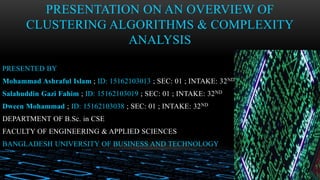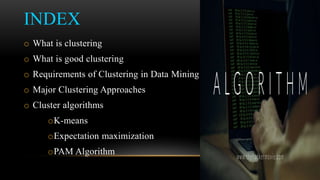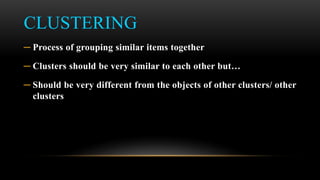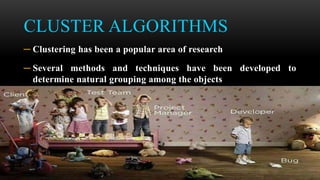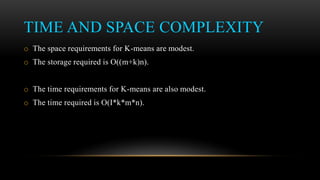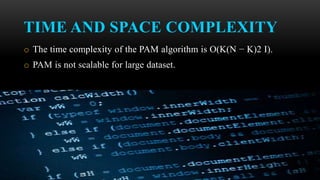Presentation on an overview of clustering algorithms & complexity analysis
- 1. PRESENTATION ON AN OVERVIEW OF CLUSTERING ALGORITHMS & COMPLEXITY ANALYSIS PRESENTED BY Mohammad Ashraful Islam ; ID: 15162103013 ; SEC: 01 ; INTAKE: 32ND Salahuddin Gazi Fahim ; ID: 15162103019 ; SEC: 01 ; INTAKE: 32ND Dween Mohammad ; ID: 15162103038 ; SEC: 01 ; INTAKE: 32ND DEPARTMENT OF B.Sc. in CSE FACULTY OF ENGINEERING & APPLIED SCIENCES BANGLADESH UNIVERSITY OF BUSINESS AND TECHNOLOGY
- 2. INDEX o What is clustering o What is good clustering o Requirements of Clustering in Data Mining o Major Clustering Approaches o Cluster algorithms oK-means oExpectation maximization oPAM Algorithm
- 3. CLUSTERING ŌöĆ Process of grouping similar items together ŌöĆ Clusters should be very similar to each other butŌĆ” ŌöĆ Should be very different from the objects of other clusters/ other clusters
- 4. WHAT IS GOOD CLUSTERING o A good clustering method will produce high quality clusters with o high intra-class similarity o low inter-class similarity Intra-cluster distances are minimized Inter-cluster distances are maximized
- 5. REQUIREMENTS OF CLUSTERING IN DATA MINING o Scalability o Ability to deal with different types of attributes o Discovery of clusters with arbitrary shape o Minimal requirements for domain knowledge to determine input parameters o Able to deal with noise and outliers o Insensitive to order of input records o High dimensionality o Incorporation of user-specified constraints o Interpretability and usability
- 6. MAJOR CLUSTERING APPROACHES o Partitioning algorithms o Hierarchy algorithms o Density-based o Grid-based o Model-based
- 7. CLUSTER ALGORITHMS ŌöĆ Clustering has been a popular area of research ŌöĆ Several methods and techniques have been developed to determine natural grouping among the objects
- 8. ROAD MAP K-means Expectation Maximization Method PAM algorithm
- 9. K-MEANS o k-means clustering is a method of vector quantization, originally from signal processing, that is popular for cluster analysis in data mining.
- 10. ADVANTAGES & DISADVANTAGES o Advantages ’ā╝ Fast, robust and easier to understand. ’ā╝ Relatively efficient. ’ā╝ Gives best result when data set are distinct or well separated from each other.
- 11. CONTINUEŌĆ”.. o Disadvantages ’āś Applicable only when mean is defined i.e. fails for categorical data. ’āś Unable to handle noisy data and outliers. ’āś Algorithm fails for non-linear data set.
- 12. TIME AND SPACE COMPLEXITY o The space requirements for K-means are modest. o The storage required is O((m+k)n). o The time requirements for K-means are also modest. o The time required is O(I*k*m*n).
- 13. EXPECTATION MAXIMIZATION o The EM (expectation maximization) technique is similar to the K- Means technique.
- 14. ADVANTAGES & DISADVANTAGES o Advantage ’ā╝ Gives extremely useful result for the real world data set. o Disadvantage ’āś Algorithm is highly complex in nature.
- 15. TIME AND SPACE COMPLEXITY ’ü▒Time computational complexity is linear in d (the number of input features), n (the number of objects) and t (the number of iterations).
- 16. PAM ALGORITHM o PAM stands for ŌĆ£partition around medoidsŌĆØ. The algorithm is intended to find a sequence of objects called medoids that are centrally located in clusters.
- 17. ADVANTAGES & DISADVANTAGES o Advantages ’ā╝ Relatively scalable and simple. ’ā╝ Suitable for datasets with compact spherical clusters that are well- separated.
- 18. CONTINUEŌĆ”. o Disadvantages ’āś Poor cluster descriptors. ’āś Reliance on the user to specify the number of clusters in advance. ’āś High sensitivity to initialization phase, noise and outliers. ’āś Frequent entrapments into local optima. ’āś Inability to deal with non-convex clusters of varying size and density.
- 19. TIME AND SPACE COMPLEXITY o The time complexity of the PAM algorithm is O(K(N ŌłÆ K)2 I). o PAM is not scalable for large dataset.
- 20. It is not our Ending ŌĆ”..It is just Our Performance ’üŗ THANK YOU :|
